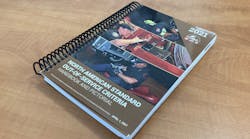In April, the 2021 changes to the North American Out-of-Service Criteria (OOSC) became effective. The OOSC instruct motor vehicle inspectors as to what mechanical or loading conditions “would likely cause an accident or breakdown,” under Federal Motor Carrier Safety Regulations section 396.9. Motor carriers cannot operate vehicles declared out-of-service until they have made the necessary repairs.
As with vehicles, drivers also can be declared out-of-service at roadside. Reasons for driver OOS include the use of alcohol or violating of the hours of service rules. FMCSA may also place motor carriers out-of-service for violating their operating authority.
Whether it is equipment, cargo, drivers or the carriers themselves, an out-of-service order means the discontinuance of related operations. In business terms, OOS means no revenue coming in while spending money on necessary repairs, replacing personnel, or remedying legal issues. Not a good combination in a low-margin business.
The impact of out-of-service violations does not stop there. Depending on the safety category, known as Behavior Analysis and Safety Improvement Categories (BASICs), out-of-service violations weigh more heavily against a motor carrier’s Compliance, Safety, Accountability (CSA) score than other violations. The negative impact of OOS on a CSA score can also affect the company’s Inspection Selection System (ISS) score and the ability to qualify for a weigh station bypass program, like PrePass.
With the repercussions that can flow from an out-of-service condition, understanding the out-of-service criteria is important. Understanding the criteria is aided by an annual schedule you can follow and a rigorous procedure in their development, with room for your participation.
The Commercial Vehicle Safety Alliance (CVSA) develops the OOSC. CVSA is an association comprised of local, state, provincial, territorial, federal commercial motor vehicle safety officials, industry representatives.
CVSA announces the annual changes to OOSC to its members at least 60 days prior to April 1 each year, the date when enforcement of the new criteria begins. It also provides the public a minimum of 30 days’ notice before the enforcement begins. That allows time for training of motor vehicle inspectors and for the education of motor carriers and their drivers.
Before those announcements, all proposed changes to the OOSC go through CVSA committees. These committees are made up of state personnel, member motor carriers and trade associations, and each provide their perspective. While state personnel hold most voting rights, industry does have a vote on each committee. From there, the CVSA board decides which proposals, those that have passed committee review and any amendments, should be balloted for vote by all member jurisdictions. The result is clarity and uniformity of out-of-service standards, across North America.
The OOSC go to the severity of violations – what is “likely to cause an accident or breakdown.” Without the OOSC process, that phrase would be undefined. The CVSA process looks at crash statistics, technical analysis, new technologies and any need for redefinition or clarification of existing criteria based on field experiences in making the determination of OOSC.
To be clear, the underlying regulations remain the rulemaking function of each country’s national motor carrier safety agency – FMCSA in the U.S., Transport Canada in that country, and Secretaría de Comunicaciones y Transportes in Mexico. With relatively few federal motor vehicle inspectors to cover the breadth of each nation, achieving inspection uniformity depends on close coordination with state, provincial and territorial inspectors and their administrations. CVSA provides the forum for that coordination.
The updated CVSA OOSC app is available through the Apple and Google Play stores. A printed copy may be ordered through the CVSA online store. To assist in avoiding an out-of-service order, know the criteria.
Steve Vaughn is the vice president of field operations at PrePass Safety Alliance, the provider of PrePass weigh station bypass service. Vaughn served nearly three decades with the California Highway Patrol and is a past president of the Commercial Vehicle Safety Alliance.



